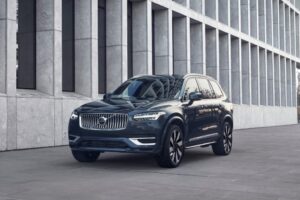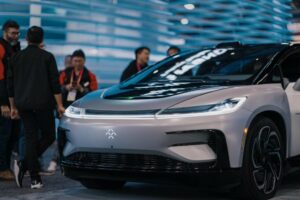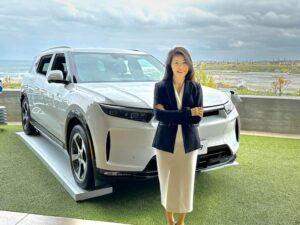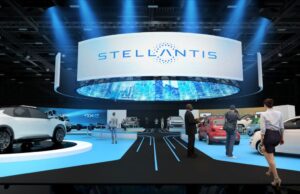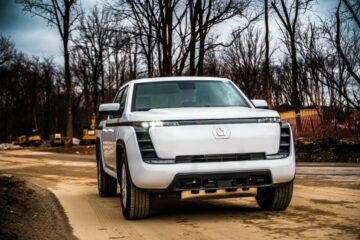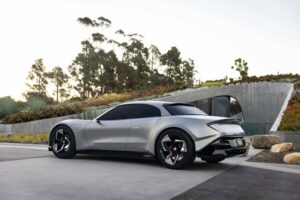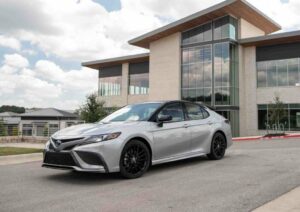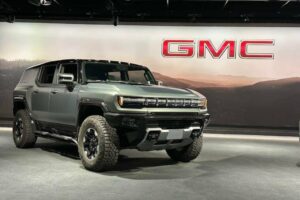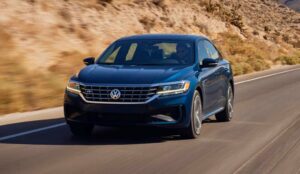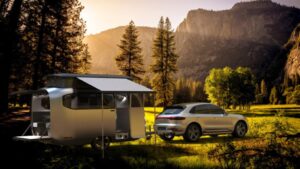Volvo introduced its newest and smallest battery electric SUV during a preview in Milan last week, the Volvo EX30. With prices starting at $34,950, before delivery fees, the 2024 EX30 will become one of the most affordable products in the EV sector when Volvo starts deliveries later this year. It also promises to be its fastest.
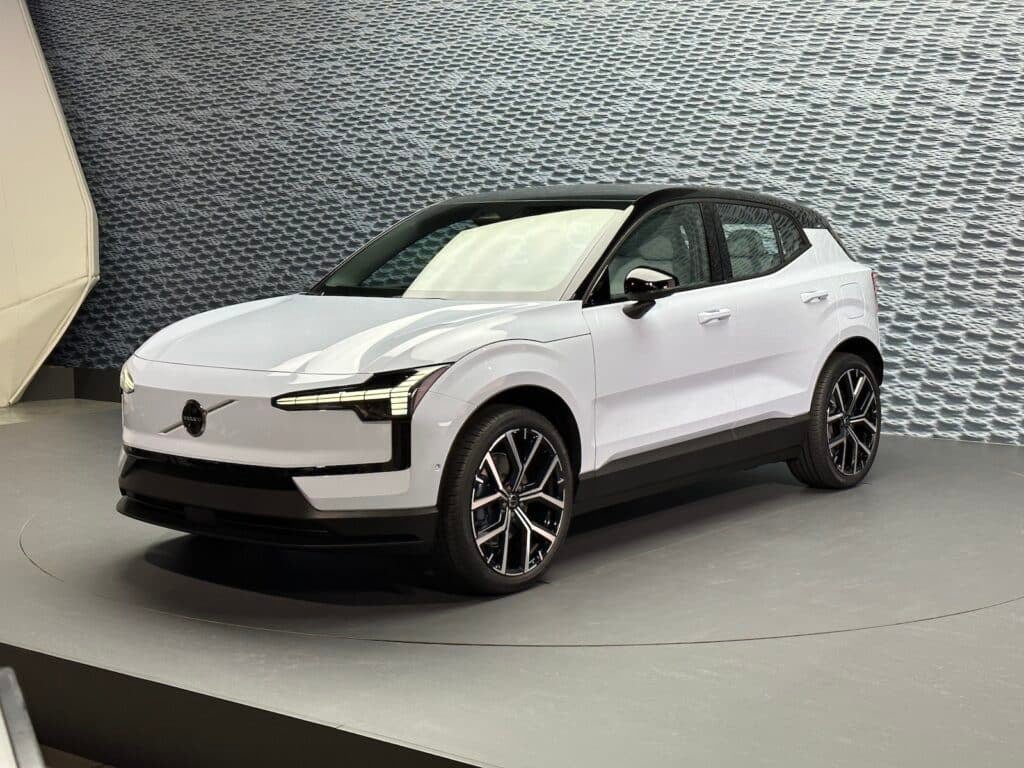
Given those prospects, TheDetroitBureau.com sat down for a chat with Jeremy Offer, the Global Head of Design for Volvo Cars.
Offer became Global Head of Design May 1, reporting to Chief Executive Officer Jim Rowan. He succeeds Robin Page who remains at Volvo as senior advisor. The interview that follows has been edited for length and clarity.
Jeremy Offer: I’m in the job five weeks now, and it’s been very intense five weeks. My profile is slightly different from most people in this position. I guess my training is not 100% automotive. I’ve worked in consultancies for about 25 years, the last seven years in an automotive startup. So, I’ve got quite a unique CV, but I think it’s very relevant for the direction that the automotive industry is heading. Vehicles are no longer about the engine; they are about core computing, the software, the UX as well as the driving experience. So that kind of unique blend comes from a background with consumer electronics devices.
And then this vehicle really kind of embodies a lot of that same those same principles, you know, human centered design approach, something that we’ve always advocated in the design teams that I’ve run before. It’s certainly pointing the direction for me for the for this new electric future that we’re about to embrace.
Start of a new era
TheDetroitBureau.com: Talk about small vehicles. Certainly, that’s kind of like the theme here. Yeah. What kind of design considerations you have to think about for a small vehicle in the U.S., where vehicles aren’t trending small.
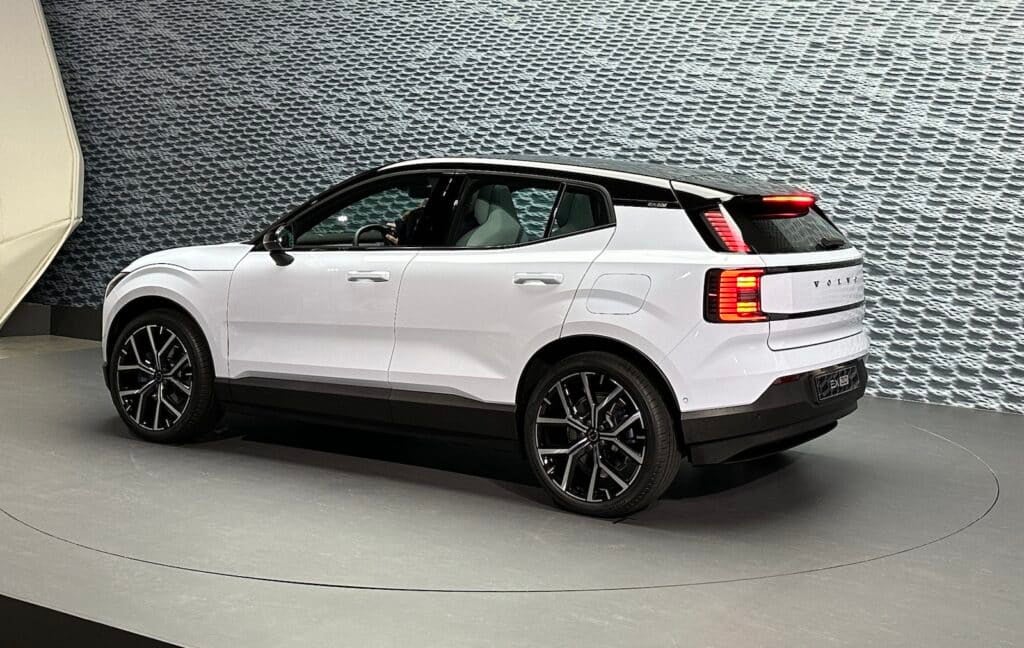
JO: Well, it’s about maximizing functionality. The design of vehicles is no longer about the styling of them, it’s no longer about how they look. It’s about how they function. And then the beauty is inherent from that. That’s really where we kind of create the aesthetic from. So, in the interior for example, it feels like a bigger vehicle because we’ve built it on an entirely electric platform. And because we haven’t got transmission tunnels, as soon as you clear out the interior and you allow function to take over, then you can start to make this feel like a much bigger vehicle.
So, the fact that we have no transmission tunnel anymore or gearbox means that we can use all of that storage meaningfully in the in the rear compartment because we’ve got this sort of double height, load bay area we can we can utilize. We can utilize the space where the engine used to be. So, there is a lot to be said for that combination of a smaller vehicle on a 100% electric platform, which we’ve never had before. Yeah, but even though we’ve been used to Volvo’s being larger vehicles, all of the design, integrity and intent that we’ve built into our larger vehicles, and the quality of the engineering everything remains exactly the same. So in that respect, it’s the same Volvo, but on a smaller platform.
TDB: Some manufacturers have made the front area smaller, but the EX30’s is still fairly sizable.
JO: This is the first generation of electric platform and a lot of the safety structures, that crash protection, still absolutely need to be there. And we wouldn’t evolve without it. So, you have removed the engine. But the engine in a traditional internal combustion vehicle is an incredible crumple zone, protecting the passenger. So when you remove that, it’s not like you can just simply move the driver and the passenger further forward, creating more space. There’s still a lot of crash structure that needs to go in there. I think what you’ll see is the next generation of electronic platforms is we will start to develop new safety features, new mechanisms and new materials that will allow us to kind of move that slightly more cab forward approach. I don’t think we’ll ever get to a complete mono volume. But frankly, I’m not sure that’s that you would want. I think you would end up with an incredibly long instrument panel if you were to do that. So this is a kind of a sweet spot for us at the moment.
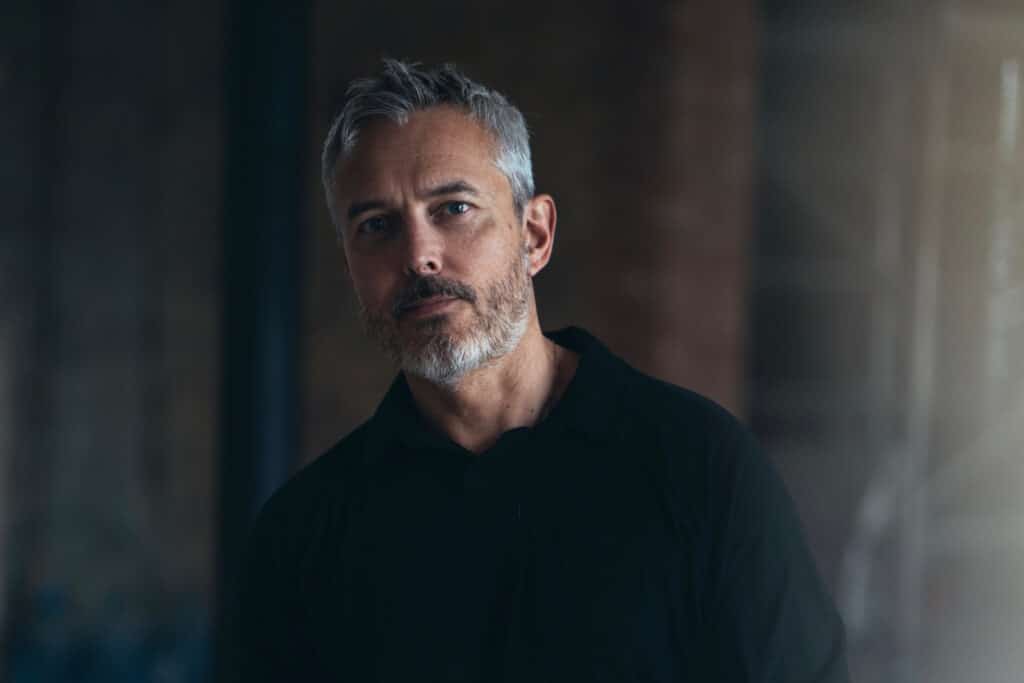
TDB: Coming to the U.S. at a $35,000 price without federal incentives, how you’re able to do that given this design approach?
JO: We really don’t want to remove cost from those valuable touch points that gives you those moments of delight. We really don’t want to cut costs from that. So, we have to look at other areas to cut costs. One of the things that I will be doing is getting designers more involved at a platform level, so that we can really start to drill down into where the cost is, and efficiencies can be made at a platform level. And that’s only going to happen with the collaboration of design, engineering, and manufacturing all working together. And so, rather than the sort of siloed approach of design, getting involved at the end of the process, I want to get involved much earlier on in the in that kind of R&D cycle. And then when you combine with the fact that this vehicle is going to be manufactured in China, we have the economies of scale of a shared platform, it does enable us to be more cost efficient. And that was frankly one of the main benefits of utilizing Geely’s technology in this area.
TDB: You were saying that you wouldn’t expect to see a monospace vehicle design. So where do you design going? What do you see in five years?
JO: Vehicle design going forward? A rational, functional design process comes in thinking about how to create an easier manufacturing assembly process. For example. So in taking all the wiring out the door of the EX30, there’s no electronics. In building that into the central area of the vehicle seems like common sense. Why would you have speakers all around, when you can create a really premium sound experience with just localizing those speakers (in a sound bar) at the front of the IP? So that that’s sort of smart thinking when it comes to the design of not just the aesthetics of it, not just the user function of it, but also the manufacturing function. So it’s also about the assembly processes, rationalizing all of that through really good design thinking.
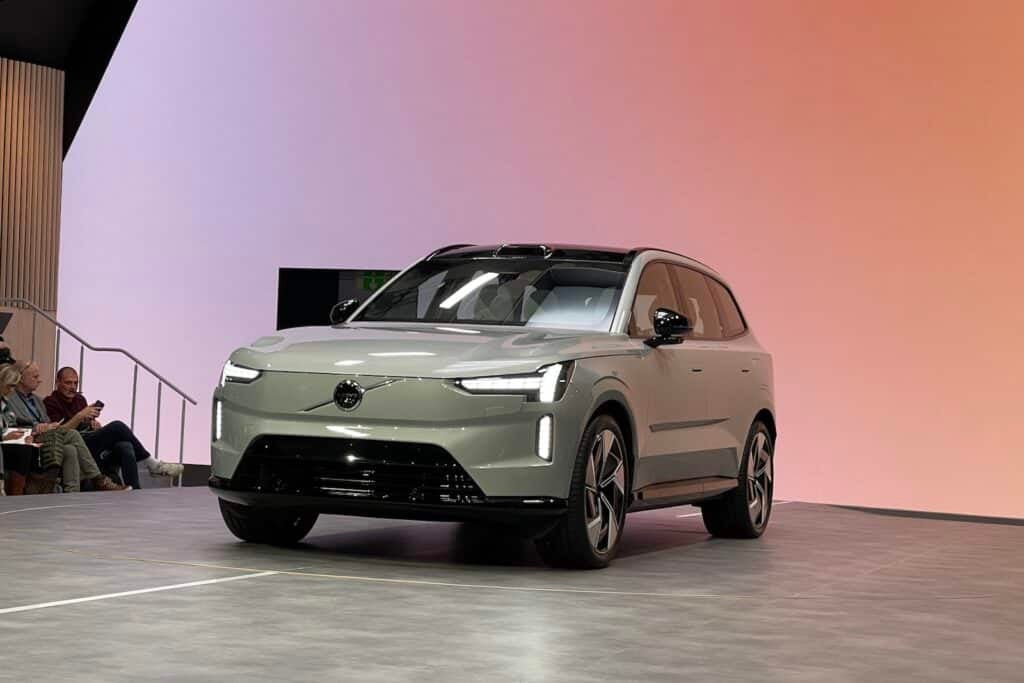
TDB: On the EX30, you don’t use an instrument cluster. You also are removing the wiring from the door and removing a lot of chrome accents. This is obviously a decarbonizing of the interior design.
JO: Yeah, totally. And that’s engineering and design working together to create the best solution for this. But you’re absolutely right. Centralizing that display; is this the right thing to do? Actually, in a small car like this, the research that we’ve done shows that screen is just as glanceable just to the right of you as it is below you. And there’s a lot of research that suggests it’s simpler to use if you’ve got one screen rather than splitting your attention between two. And on top of that, you’re obviously using fewer PCBs, fewer LCDs, less plastic, and that inevitably creates a saving.
TDB: So, what usually comes first in a situation like this, or does it just come together at the same time?
JO: Some ideas come from design, some ideas come from engineering, some ideas come from a collaborative workshop on this particular subject, where we create cross-functional teams to come up with the best solutions. So, it really just depends on you know, what it is that we’re focusing on.
TDB: The use of alternative, recyclable materials work really well at this price point. Is it a bit harder to get it to translate into an EX90?
JO: No, absolutely not. It’s at the heart of our philosophy. We’ve stated that we will be a fully circular company by 2040. We’ve already got 95% of our Tier One suppliers committed to 100% renewable energy to power their factories by 2025. That it’s a whole value chain is embedded in this philosophy. It’s not just about you know, just a sprinkling of recycled material here; it’s embedded in the entire DNA of the business.
Electric evolution
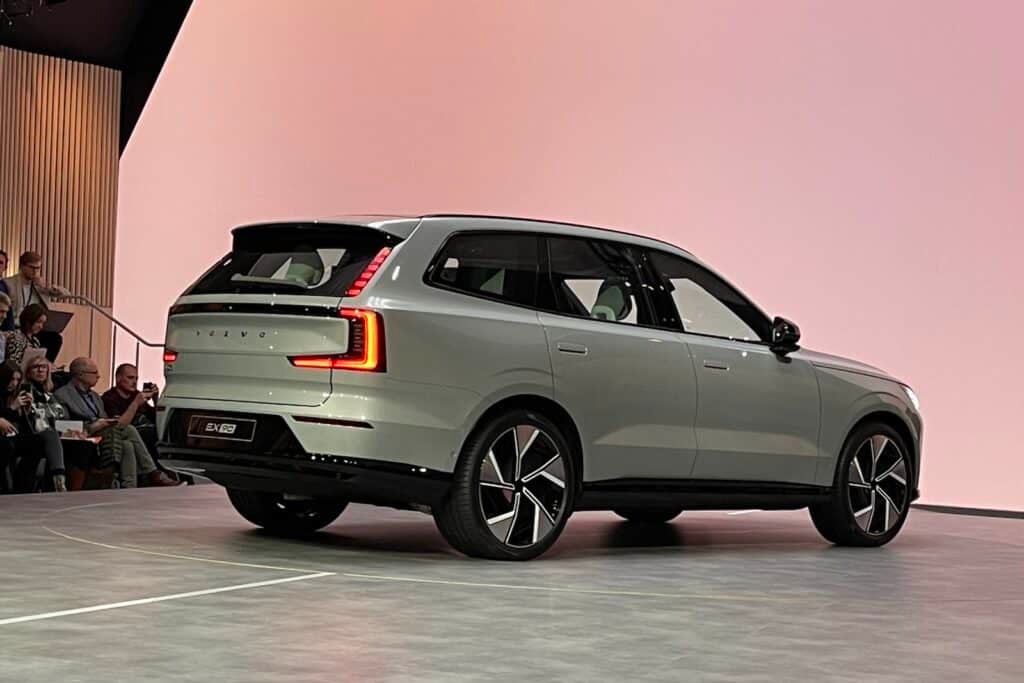
TDB: You’ve talked about using modular architecture for your EV platforms. It would seem easier to use, since the scalable modular architecture with similar EV drivelines keeps everything down low and out of the way.
JO: It needs some very smart thinking, particularly around areas like grid architecture, making sure that componentry fits within a certain space envelope. So, you package protect the technology, and then as the technology changes, you can keep the footprint the same. And another reason for centralizing the technology (in the cabin’s platform, as on the EX30) is that all of the clutter, like those wiring looms, we bring into this centralized area, keeping the doors free. Keeping the assembly process much easier. The platform becomes this modular piece of tech in its own in its own right.
TDB: So from the platform down, it’s all the same. From the platform up, it can be anything. Doesn’t that just make your mind explode with possibilities?
JO: Yeah, it’s brilliant. We can change the wheelbase. We add more batteries in and we change the componentry inverters. But it’s there. We just sort of pipe it up through the middle. That’s the idea. That’s the that’s the end state is that we can kind of really reduce the amount of wiring the amount of complexity to take the complexity out of the process. When you’re dealing with more of a solid state environment, it’s much easier to do as there are no moving parts anymore. And this is where this this is where my background as an industrial designer, have working with PCBs components on PCBs and housing electronics, is really relevant. Because no longer are we having to house big kind of engines, big lumps of metal. It’s much sleeker.
TDB: As you think about brand heritage, are there any key Volvo models of the past come to mind?
JO: Well, obviously, as a designer, the wagons have been a key signature in the Volvo landscape. And then of course, I’d be it’d be remiss if I didn’t mention the P1800. Although it wasn’t a huge hit for Volvo, you know, it was a beautiful thing. So yeah, those are those are two that really sort of stand out for me and the opposite ends of the spectrum, which is really interesting that a brand like Volvo can capture the imagination with two completely different vehicles.
- SEO Powered Content & PR Distribution. Get Amplified Today.
- EVM Finance. Unified Interface for Decentralized Finance. Access Here.
- Quantum Media Group. IR/PR Amplified. Access Here.
- PlatoAiStream. Web3 Data Intelligence. Knowledge Amplified. Access Here.
- Source: https://www.thedetroitbureau.com/2023/06/qa-jeremy-offer-global-head-of-design-volvo-cars/
- :has
- :is
- :not
- :where
- $UP
- 000
- 1
- 2024
- 2025
- 25
- 95%
- a
- Able
- About
- absolutely
- actually
- add
- advisor
- affordable
- All
- all-electric
- allow
- already
- also
- alternative
- Although
- always
- amount
- an
- and
- Another
- any
- anymore
- anything
- approach
- architecture
- ARE
- AREA
- areas
- around
- arrival
- AS
- Assembly
- At
- attention
- automotive
- automotive industry
- background
- bar
- batteries
- battery
- Bay
- BE
- beautiful
- Beauty
- became
- because
- become
- becomes
- been
- before
- being
- below
- benefits
- BEST
- between
- Big
- bigger
- Bit
- Blend
- brand
- brilliant
- bring
- Building
- built
- Bureau
- business
- but
- by
- call
- CAN
- capture
- car
- cars
- centered
- central
- centralized
- certain
- certainly
- chain
- change
- Changes
- chief
- chief executive officer
- China
- Chrome
- clarity
- clear
- Cluster
- clutter
- collaboration
- collaborative
- COM
- combination
- combine
- come
- comes
- committed
- Common
- company
- Company’s
- complete
- completely
- complexity
- components
- computing
- considerations
- consumer
- Consumer electronics
- Core
- Cost
- Costs
- course
- Crash
- create
- creates
- Creating
- cross-functional teams
- Cut
- cut costs
- cycle
- dealing
- debut
- delight
- Deliveries
- delivery
- depends
- Design
- design process
- design thinking
- designed
- Designer
- designers
- develop
- Development
- Devices
- different
- direction
- Display
- dna
- do
- does
- Doesn’t
- doing
- done
- Dont
- Door
- doors
- double
- down
- driver
- driving
- during
- Earlier
- easier
- economies
- Economies of Scale
- efficiencies
- efficient
- Electric
- Electronic
- Electronics
- embedded
- embodies
- embrace
- enable
- end
- ends
- energy
- Engine
- Engineering
- Engines
- Entire
- entirely
- Environment
- EV
- Even
- EVER
- everything
- evolve
- exactly
- example
- executive
- Executive Officer
- expect
- experience
- fact
- factories
- fairly
- fastest
- Features
- Federal
- feel
- Fees
- fewer
- First
- First Generation
- five
- flagship
- Floor
- focusing
- follows
- Footprint
- For
- Force
- Forward
- Free
- from
- front
- full
- fully
- function
- functional
- functionality
- further
- future
- generation
- get
- getting
- given
- gives
- Global
- Go
- going
- good
- Grid
- had
- happen
- Have
- having
- he
- head
- Heading
- Heart
- height
- here
- heritage
- Hit
- House
- housing
- How
- How To
- HTTPS
- huge
- human
- i
- idea
- ideas
- if
- imagination
- in
- Incentives
- incredible
- incredibly
- industrial
- industry
- inevitably
- inherent
- instrument
- integrity
- intent
- interesting
- interior
- internal
- Interview
- into
- introduced
- involved
- IP
- IT
- ITS
- Jim
- Job
- Joins
- jpg
- just
- Keep
- keeping
- Key
- Kind
- Know
- landscape
- larger
- Last
- later
- Length
- less
- Level
- like
- load
- Long
- longer
- Look
- Lot
- Low
- made
- Main
- make
- Making
- manufactured
- Manufacturers
- manufacturing
- material
- materials
- max-width
- maximizing
- May..
- means
- mechanisms
- metal
- Middle
- MILAN
- mind
- models
- modular
- moment
- Moments
- more
- most
- Motors
- move
- moves
- moving
- much
- my
- Need
- needs
- never
- New
- Newest
- next
- no
- now
- of
- offer
- Officer
- on
- ONE
- only
- opposite
- or
- Other
- our
- out
- over
- own
- Pack
- package
- page
- panel
- particular
- particularly
- parts
- past
- PCBs
- People
- philosophy
- piece
- pipe
- plastic
- platform
- Platforms
- plato
- Plato Data Intelligence
- PlatoData
- Point
- points
- position
- possibilities
- power
- Premium
- Preview
- price
- Prices
- principles
- process
- processes
- Production
- Products
- Profile
- promises
- prospects
- protect
- protecting
- protection
- quality
- R&D
- rather
- Rational
- really
- reason
- reduce
- relevant
- remains
- remove
- Removed
- removing
- Renewable
- renewable energy
- Reporting
- research
- respect
- Reveals
- right
- Robin
- Run
- s
- Safety
- Said
- same
- saving
- saying
- scalable
- Scale
- Screen
- sector
- see
- seem
- seems
- senior
- sense
- seven
- shared
- Shows
- similar
- simply
- since
- situation
- sizable
- slightly different
- small
- smaller
- smart
- So
- Software
- solely
- solid
- solution
- Solutions
- some
- something
- Soon
- Sound
- Space
- speakers
- Spectrum
- spent
- Spot
- stand
- start
- Starting
- starts
- startup
- State
- stated
- Still
- storage
- structure
- subject
- Suggests
- suppliers
- sweet
- Take
- taking
- teams
- tech
- Technology
- than
- that
- The
- their
- Them
- theme
- then
- There.
- they
- thing
- things
- think
- Thinking
- this
- this year
- those
- though?
- Through
- tier
- Tier One
- time
- to
- together
- top
- TOTALLY
- touch
- traditional
- Training
- translate
- trending
- two
- u.s.
- under
- unique
- us
- use
- used
- User
- using
- usually
- utilize
- Utilizing
- ux
- Valuable
- value
- vehicle
- Vehicles
- very
- volume
- volvo
- want
- was
- Way..
- we
- week
- Weeks
- WELL
- were
- What
- when
- which
- WHO
- whole
- why
- will
- with
- within
- without
- Work
- worked
- working
- workshop
- would
- year
- years
- you
- Your
- zephyrnet


